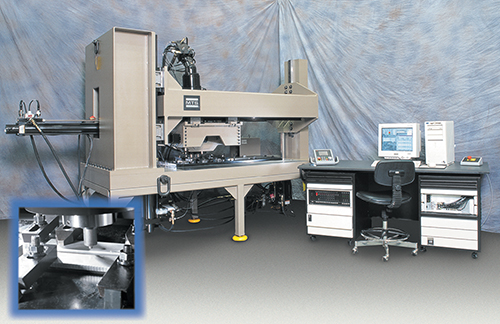New Tool Creates a Big Stir
NASA inventors and engineers are constantly developing revolutionary new technologies. Jeff Ding, an engineer at NASA's Marshall Space Flight Center, invented a new self-adjusting pin tool for a process known as friction stir welding. The technology is jointly licensed to MTS Systems Corporation, of Eden Prairie, Minnesota, and MCE Technologies, Inc., of Seattle, Washington.
Friction stir welding is a process that makes straight-line welds without bringing the parent material to a liquid state. This is accomplished through high-speed rotation, which generates frictional heat between the welding tool and the piece being welded. This heat causes the material to soften to the point of plasticity without allowing it to melt. The plasticized material is then transferred from the front edge of the welding tool to the trail edge, where it joins the pieces being welded. However, a major flaw of this method is its reliance on a single-piece pin tool. The weld is left unfinished and a hole remains where the pin was inserted. The hole must be covered with a rivet in order to preserve the integrity of the weld. Using the new NASA-developed pin tool eliminates the need for this finishing step.
The friction stir welding process used in MTS and MCE systems includes the new self-adjusting, retractable pin tool. The pin is inserted between the two pieces of material to be joined. Passing back to the original point, the pin slowly retracts back into the tool. This retraction allows continuous rewelding at lesser depths, until the hole is completely closed. Because the automatic pin tool makes a 360-degree weld with no insertion holes, these systems have an advantage over welding systems that do not use the tool.
With this NASA technology, welding of higher strength alloys, as well as non-planer and variable thickness structures can be achieved, and the technology is now used in the manufacturing of components for the Space Shuttle. According to Jeff Ding, This new welding process will allow for stronger and more reliable welds on NASA's Space Shuttle External Tanks. The retractable pin produces a more stable weld of the Tanks' metals that have varied thicknesses.
The new process is a great success in the private sector. Friction stir welding technology is revolutionizing the fabrication industry, said Mike Skinner, MTS Business Development Manager for Advanced Manufacturing Technology. He continued, It is already used to manufacture Delta rockets, marine vessels, and automobiles, and will soon be used for commercial aircraft. We're seeing active interest from companies worldwide. The growth potential is exciting and the adjustable pin tool technology will make many new applications feasible.
Currently, the new technology is utilized in the manufacturing of aerospace and aircraft frames. Applications are projected for the defense industry, and according to Ding, the technology could be used to weld shut canisters used for the containment of radioactive waste.

The MTS Friction Stir Welding Process Development System uses the NASA-developed self-adjusting, retractable pin tool to offer welding capabilities that were previously unachievable with other welding systems.













